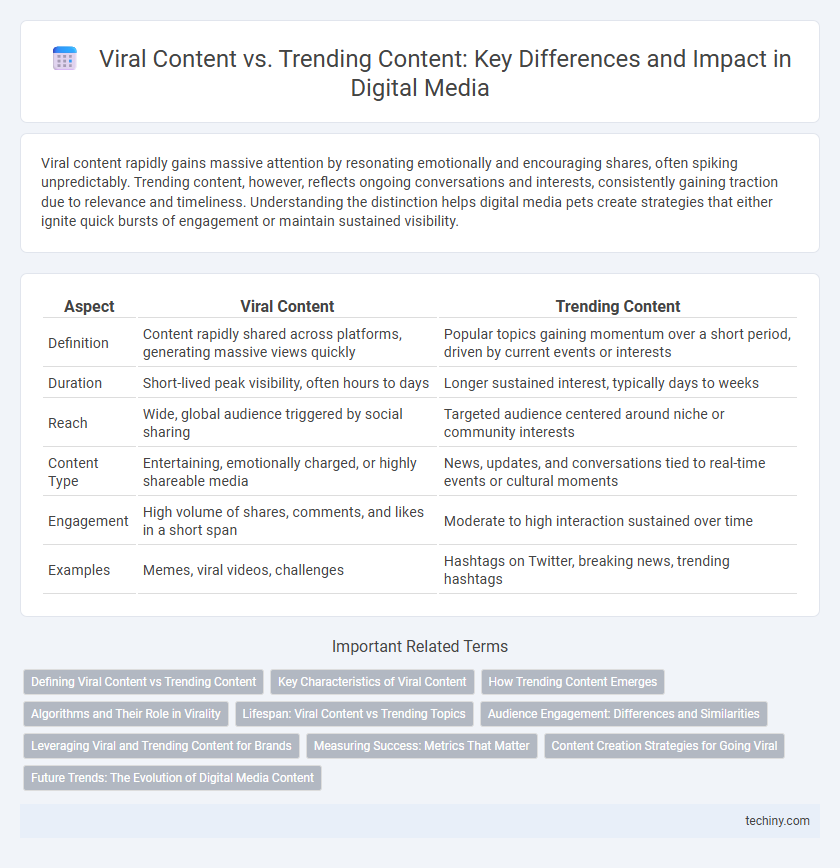Viral content rapidly gains massive attention by resonating emotionally and encouraging shares, often spiking unpredictably. Trending content, however, reflects ongoing conversations and interests, consistently gaining traction due to relevance and timeliness. Understanding the distinction helps digital media pets create strategies that either ignite quick bursts of engagement or maintain sustained visibility.
Table of Comparison
| Aspect | Viral Content | Trending Content |
|---|---|---|
| Definition | Content rapidly shared across platforms, generating massive views quickly | Popular topics gaining momentum over a short period, driven by current events or interests |
| Duration | Short-lived peak visibility, often hours to days | Longer sustained interest, typically days to weeks |
| Reach | Wide, global audience triggered by social sharing | Targeted audience centered around niche or community interests |
| Content Type | Entertaining, emotionally charged, or highly shareable media | News, updates, and conversations tied to real-time events or cultural moments |
| Engagement | High volume of shares, comments, and likes in a short span | Moderate to high interaction sustained over time |
| Examples | Memes, viral videos, challenges | Hashtags on Twitter, breaking news, trending hashtags |
Defining Viral Content vs Trending Content
Viral content refers to media that rapidly gains widespread attention and engagement across digital platforms due to its highly shareable and emotionally resonant nature. Trending content, on the other hand, consists of topics or posts that gain popularity within a short time frame, driven by current events, hashtags, or platform algorithms. Understanding the distinction helps digital marketers tailor strategies to either spark viral sharing or capitalize on trending topics for timely visibility.
Key Characteristics of Viral Content
Viral content is characterized by rapid, exponential sharing across multiple platforms driven by strong emotional appeal, relatability, or novelty. This type of content often leverages visual elements, humor, or controversy to maximize user engagement and organic reach. Unlike trending content, which gains popularity due to current events or influencer promotion, viral content sustains momentum through authentic user interaction and widespread peer-to-peer dissemination.
How Trending Content Emerges
Trending content emerges through a combination of rapid audience engagement and algorithmic promotion across social media platforms, driven by timely relevance and relatable themes. Key factors include user interaction metrics such as shares, comments, and likes, which signal content popularity to algorithms prioritizing real-time visibility. Platforms like TikTok, Twitter, and Instagram leverage these data points to amplify emerging trends, creating a feedback loop that sustains content momentum.
Algorithms and Their Role in Virality
Algorithms play a crucial role in determining viral content by analyzing user engagement metrics such as shares, likes, and comments to prioritize distribution on platforms like TikTok and Instagram. Trending content, on the other hand, benefits from algorithmic recognition of rapid spikes in activity that signal emerging popular topics or hashtags. The precise calibration of these algorithms influences the visibility and reach of digital media, directly impacting which pieces achieve virality or trend status.
Lifespan: Viral Content vs Trending Topics
Viral content typically experiences a rapid surge in engagement, reaching millions within hours or days but often has a short lifespan as audience interest quickly shifts. Trending topics may develop more gradually and sustain public interest over a longer period, sometimes lasting weeks due to ongoing discussions or news cycles. Understanding these lifespan differences is crucial for digital media strategies aiming to maximize reach and maintain audience engagement.
Audience Engagement: Differences and Similarities
Viral content rapidly captures a vast audience through explosive sharing, often driven by emotional impact or novelty, whereas trending content gains attention through sustained interest and relevance within specific communities or timeframes. Both types of content generate high audience engagement, but viral content typically spikes quickly and fades fast, while trending content maintains longer-term interaction and discussion. Understanding these dynamics helps digital media strategists tailor campaigns to either maximize immediate reach or foster ongoing participation.
Leveraging Viral and Trending Content for Brands
Leveraging viral and trending content allows brands to rapidly expand their audience reach and boost engagement by tapping into current conversations and popular culture. Viral content offers exponential visibility through shares and organic growth, while trending content provides timely relevance by aligning campaigns with ongoing social media discussions and hot topics. Brands integrating both strategies can maximize impact, enhance brand awareness, and drive conversion rates effectively within dynamic digital media landscapes.
Measuring Success: Metrics That Matter
Viral content is typically measured by rapid spike in shares, views, and engagement metrics within a short timeframe, indicating widespread audience reach and organic amplification. Trending content success is gauged through sustained visibility on platforms like Twitter Trends or Google Trends, reflecting ongoing relevance and user interest. Key performance indicators for both include unique views, share rate, engagement rate, and conversion rate to evaluate immediate impact and long-term value.
Content Creation Strategies for Going Viral
Viral content relies on emotional resonance, shareability, and timely relevance to rapidly engage a wide audience across social media platforms, making it essential for content creators to focus on storytelling that sparks strong emotional reactions such as humor, surprise, or inspiration. Trending content capitalizes on current events, popular topics, or hashtags gaining momentum, requiring creators to monitor real-time analytics and adapt their content to fit emerging discussions, enhancing visibility through strategic tagging and participation. Prioritizing original, high-quality visuals and concise messaging tailored for specific platforms amplifies the potential for virality, while maintaining authenticity ensures sustained audience trust in digital media campaigns.
Future Trends: The Evolution of Digital Media Content
Viral content captivates audiences rapidly through emotional resonance and shareability, while trending content reflects real-time user interest and platform algorithms. The future of digital media content hinges on AI-driven personalization and immersive experiences like AR and VR to enhance engagement. Emerging technologies will blur lines between viral and trending content, creating dynamic, adaptive media ecosystems.
Viral Content vs Trending Content Infographic

 techiny.com
techiny.com